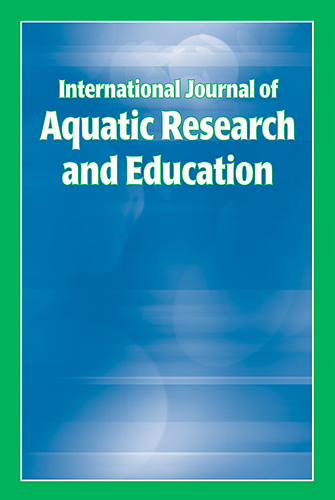Home > Journals > IJARE > Vol. 11 > No. 3 (March 2019)
Volume 11, Number 3 (March 2019)
In This Issue 11(3)
Greetings, readers of the International Journal of Aquatic Research and Education, and welcome to this latest issue. I am very excited about the five intriguing research articles. I believe you will find most of them to be of particular interest regardless of your particular areas of interest or expertise.
Editorial
This third issue of Volume 11 starts with my own short editorial dealing with a novel concept, "self-agency" (i.e., a person's sense of how much control they have over their own body and actions). I argue that we should be paying attention to how we are teaching children to swim and how we should allow each child more self-control and choice during the learn-to-swim process by using developmentally appropriate practices. I suspect it may be one of my more controversial editorials. I welcome responses in the form of letters to the editor! Bring them on!
Research Articles As I mentioned in the first paragraph, this issue features five research articles that I encourage you to read and study.
The first article, "Unintentional Bathtub Drowning Deaths among Those Aged 65 Years and Older in Australia," comes from "down under" and an outstanding group of authors, Amy Peden, Richard C. Franklin, John H. Pearn, and Alison J. Mahony from James Cook University and the Royal Life Saving Society - Australia. This fascinating study about drownings in the home environment among older adults examined the factors that impact these tragedies.
The second article is one from a lengthy line of inquiries by lead authors, Carol and Dick Irwin, and their colleagues, including in this case, Jennifer R. Pharr and Todd E. Layne. U.S.A. Swimming has funded a series of their studies dealing with swimming among minority groups in the U.S. which have exposed important realities about the mostly Euro-American focus of swimming in our culture. The current study, "An Investigation of Youth Swimming Skills and Method of Instruction," examines how the swimming skill level of children and adolescents was associated with how they learned to swim (i.e., via formal or informal instruction or self-taught).
Our most prolific journal author, Kevin Moran, from the University of Auckland, NZ, brings us the third research article, a second drowning prevention study about one of the key water competency tasks, floating. In "Can You Float? Part 2 - Perceptions and Practice of Lifejacket Use among Young Adults," Kevin has explored floating skills aided by PFDs and how they relate to the pre- and post-performance perceptions among a group of young adults. His previous study and manuscript, published in Vol. 10, issue 4, featured the same approach to floating, sans buoyancy aides. Both of these studies are "must reads" for those interested in drowning prevention and water competence.
The fourth article, "Cardiorespiratory Responses to Shallow Water Exercise: A Sex Comparison, comes from a research group at Central Washington University. The authors, Mitchell Garant Fisher, Laura Jean Miller, Jerusalem Tesfaye, Karen Roemer, Debra Mary D'Acquisto, and Leo Joseph D'Acquisto, have prepared a very detailed study examining how men's and women's responses to shallow water exercise, especially high-intensity, using a wide range of physiological measures. For those interested in water exercise and therapy, this paper ought to be an important read.
The final research article in this third issue, "Validation of a New Incremental Swim Test as a Tool for Maximum Oxygen Uptake Analysis in Lifeguards," comes from a large collaborative research group from several Spanish Universities. Authors, Brais Ruibal-Lista (University of A Coruña), José Palacios-Aguilar (University of A Coruña), José Antonio Prieto (University of Oviedo), Sergio López-García (Pontifical University of Salamanca), José Antonio Cecchini-Estrada (University of Oviedo), Miguel Santiago-Alonso (University of A Coruña), Cristian Abelairas-Gómez (University of Santiago de Compostela), created and validated an incremental fitness swimming test to evaluate the fitness levels of lifeguards. The swimming test reminded me of the Pacer item that is part of the current FitnessGRAM fitness test that is popular in the U.S. I think variations on this lifeguard test might actually be constructed to evaluate the fitness levels of competitive and lap swimmers.
I hope you enjoy reading these articles. I certainly have. As always, good reading!
Steve Langendorfer
Founding Editor
International Journal of Aquatic Research and Education
Editorial
Self-agency and Swimming: Letting Babies Be Your Teachers
Stephen J. Langendorfer Ph.D.
Research Articles
An Investigation of Youth Swimming Skills and Method of Instruction
Carol C. Irwin, Jennifer R. Pharr, Todd E. Layne, and Richard L. Irwin
Can You Float? Part 2 - Perceptions and Practice of Lifejacket Use Among Young Adults
Kevin Moran Ph.D.
Unintentional Bathtub Drowning Deaths Among Those Aged 65 Years and Older in Australia
Amy E. Peden, Richard C. Franklin, John H. Pearn M.D., and Alison J. Mahony
Cardiorespiratory Responses to Shallow Water Exercise: A Sex Comparison
Mitchell Garant Fisher, Laura Jean Miller, Jerusalem Tesfaye, Karen Roemer, Debra Mary D'Acquisto, and Leo Joseph D'Acquisto
Validation of a New Incremental Swim Test as a Tool for Maximum Oxygen Uptake Analysis in Lifeguards
Brais Ruibal-Lista, José Palacios-Aguilar, José Antonio Prieto, Sergio López-García, José Antonio Cecchini-Estrada, Miguel Santiago-Alonso, and Cristian Abelairas-Gómez
